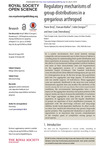Regulatory mechanisms of group distributions in a gregarious arthropod
| dc.contributor.author | Broly, Pierre | en_US |
| dc.contributor.author | Mullier, Romain | en_US |
| dc.contributor.author | Devigne, Cédric | en_US |
| dc.date.accessioned | 2016-10-11T05:37:05Z | |
| dc.date.available | 2016-10-11T05:37:05Z | |
| dc.date.issued | 2015 | en_US |
| dc.identifier.other | HPU4160635 | en_US |
| dc.identifier.uri | https://lib.hpu.edu.vn/handle/123456789/23522 | en_US |
| dc.description.abstract | In a patchy environment, how social animals manage conspecific and environmental cues in their choice of habitat is a leading issue for understanding their spatial distribution and their exploitation of resources. Here, we experimentally tested the effects of environmental heterogeneities (artificial shelters) and some of their characteristics (size and fragmentation) on the aggregation process of a common species of terrestrial isopod (Crustacea). | en_US |
| dc.format.extent | 10 p. | en_US |
| dc.format.mimetype | application/pdf | en_US |
| dc.language.iso | en | en_US |
| dc.subject | Biology | en_US |
| dc.subject | Behaviour | en_US |
| dc.subject | Ecology | en_US |
| dc.subject | Aggregation | en_US |
| dc.subject | Patchy environment | en_US |
| dc.title | Regulatory mechanisms of group distributions in a gregarious arthropod | en_US |
| dc.type | Article | en_US |
| dc.size | 903KB | en_US |
| dc.department | Education | en_US |
Files in this item
This item appears in the following Collection(s)
-
Education [806]

